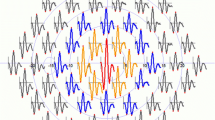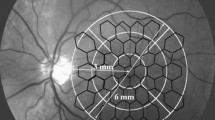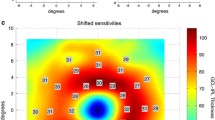Abstract
Purpose
The purpose of the present study was to compare retinal function between the perifoveal nasal and perifoveal temporal areas of diabetic eyes using multifocalERG (mfERG).
Methods
We included 36 eyes from 27 patients with diabetes (age 58 ± 14 years; duration of diabetes 13 ± 9 years; HbA1c 7.1 ± 1.8%) and a control group with 18 eyes from 18 healthy subjects (age 57 ± 11 years). Retinal thickness was assessed with optical coherence tomography (OCT) in the perifoveal areas corresponding to the summed nasal and temporal inner and outer areas. MfERG amplitude and implicit time were recorded from corresponding areas.
Results
Diabetic eyes showed lower mfERG amplitude in the nasal area than in the temporal area (14 ± 6 vs 17 ± 7 nV/deg2; p < 0.0001) and longer implicit time (31 ± 3 vs 30 ± 3 ms; p = 0.005). In the control group, there were no significant differences between the two areas.
Conclusion
Diabetic eyes showed lower amplitude and longer implicit time in the nasal area than in the temporal, which might indicate that the nasal area is more vulnerable. These findings may be of importance for evaluation of diabetic maculopathy and outcome after laser treatment.



Similar content being viewed by others
References
Moss SE, Klein R, Klein BEK (1988) The incidence of vision loss in a diabetic population. Ophthalmology 95:1340–1348
Arend O, Wolf S, Jung F, Bertram B, Pöstgens H, Toonen H, Reim M (1991) Retinal microcirculation in patients with diabetes mellitus: dynamic and morphological analysis of perifoveal capillary network. Br J Ophthalmol 75(9):514–518
Wolff BE, Bearse MA Jr, Schneck ME, Barez S, Adams AJ (2010) Multifocal VEP (mfVEP) reveals abnormal neuronal delays in diabetes. Doc Ophthalmol 121(3):189–196
Bloodworth JM Jr (1962) Diabetic retinopathy. Diabetes 11:1–22
Biallosterski C, van Velthoven ME, Michels RP, Schlingemann RO, DeVries JH, Verbraak FD (2007) Decreased OCT measured pericentral retinal thickness in patients with diabetes mellitus type I with minimal diabetic retinopathy. Br J Ophthalmol 91(9):1135–1138
van Dijk HW, Verbraak FD, Kok PH, Garvin MK, Sonka M, Lee K, Devries JH, Michels RP, van Velthoven ME, Schlingemann RO, Abràmoff MD (2010) Decreased retinal ganglion cell layer thickness in patients with type 1 diabetes. Invest Ophthalmol Vis Sci 51(7):3660–3665
Early Treatment Diabetic Retinopathy Study Research Group (1985) Photocoagulation for diabetic macular edema: ETDRS report number 1. Arch Ophthalmol 103:1796–1806
Browning DJ, Altaweel MM, Bressler NM, Bressler SB, Scott IU, Diabetic Retinopathy Clinical Research Network (2008) Diabetic macular edema: what is focal and what is diffuse? Am J Ophthalmol 146(5):649–655
Browning DJ, McOwen MD, Bowen RM, O’Marah TL (2004) Comparison of the clinical diagnosis of diabetic macular edema with diagnosis by optical coherence tomography. Ophthalmology 111:712–715
Hee MR, Puliafito CA, Wong C, Duker JS, Reichel E, Rutledge B, Schuman JS, Swanson EA, Fujimoto JG (1995) Quantitative assessment of macular edema with optical coherence tomography. Arch Ophthalmol 113(8):1019–1029
Nunes S, Pereira I, Santos A, Bernardes R, Cunha-Vaz J (2010) Central retinal thickness measured with HD-OCT shows a weak correlation with visual acuity in eyes with CSME. Br J Ophthalmol 94(9):1201–1204
Holm K, Larsson J, Lövestam-Adrian M (2007) In diabetic retinopathy, foveal thickness of 300 μm seems to correlate with functionally significant loss of vision. Doc Ophthalmol 114:117–124
Alasil T, Keane PA, Updike JF, Dustin L, Ouyang Y, Walsh AC, Sadda SR (2010) Relationship between optical coherence tomography retinal parameters and visual acuity in diabetic macular edema. Ophthalmology 117(12):2379–2386
Mitchell P, Bandello F, Schmidt-Erfurth U, Lang GE, Massin P, Schlingemann RO, Sutter F, Simader C, Burian G, Gerstner O, Weichselberger A; RESTORE study group (2011) Ranibizumab monotherapy of combined with laser versus laser monotherapy for diabetic macular edema. Ophthalmology 118(4):615–625
Curcio CA, Sloan KR, Kalina RE, Hendrickson AE (1990) Human photoreceptor topography. J Comp Neurol 292(4):497–523
Curcio CA, Allen KA (1990) Topography of ganglion cells in human retina. J Comp Neurol 300(1):5–25
Chan A, Duker JS, Ko TH, Fujimoto JG, Schuman JS (2006) Normal macular thickness measurements in healthy eyes using Stratus optical coherence tomography. Arch Ophthalmol 1224(2):193–198
Silva MF, Mateus C, Ries A, Nunes S, Fonseca P, Castelo-Branco M (2010) Asymmetry of visual sensory mechanisms: Electrophysiological, structural, and phsychophysical evidences. J Vis 10(6):26
Hudson C, Flanagan JG, Turner GS, Chen HC, Rawji MH, McLeod Dl (2005) Exaggerated relative nasal-temporal symmetry of macular capillary blood flow in patients with clinically significant diabetic macular oedema. Br J Ophthalmol 89:142–146
Early Treatment Diabetic Retinopathy Study Research Group (1991) Early photocoagulation for diabetic retinopathy: ETDRS report number 9. Ophthalmology 98:766–785
Hood DC, Bach M, Brigell M, Keating D, Kondo M, Lyons JS, Palmowski-Wolfe AM (2008) ISCEV guidelines for clinical multifocal electroretinography (2007 edition). Doc Ophthalmol 116(1):1–11
Holm K, Ponjavic V, Lövestam-Adrian M (2010) Using multifocal electroretinography hard exudates affect macular function in eyes with diabetic retinopathy. Graefes Arch Clin Exp Ophthalmol 248:1241–1247
Moss SE, Klein R, Klein BEK (1994) Ten year incidence of visual loss in a diabetic population. Ophthalmology 101:1061–1070
Lieth E, Gardner TW, Barber AJ, Antonetti DA; Penn State Retina Research Group (2000) Retinal neurodegeneration: early pathology in diabetes. Clin Experiment Ophthalmol 28(1):3–8
Bronson-Castain KW, Bearse MA Jr, Neuville J, Jonasdottir S, King-Hooper B, Barez S, Schneck ME, Adams AJ (2009) Adolescents with Type 2 diabetes: early indications of focal retinal neuropathy, retinal thinning, and venular dilation. Retina 29(5):618–626
Ng JS, Bearse MA Jr, Schneck ME, Barez S, Adams AJ (2008) Local diabetic retinopathy prediction by multifocal ERG delays over 3 years. Invest Ophthalmol Vis Sci 49(4):1622–1628
Bearse MA Jr, Han Y, Schneck ME, Adams AJ (2004) Retinal function in normal and diabetic eyes mapped with the slow flash multifocal electroretinogram. Invest Ophthalmol Vis Sci 45(1):296–304
Scott TM, Foote J, Peat B, Galway G (1986) Vascular and neural changes in the rat optic nerve following induction of diabetes with streptozotocin. J Anat 144:145–152
Hood DC, Frishman LJ, Saszik S, Viswanathan S (2002) Retinal origins of the primate multifocal ERG: implications for the human response. Invest Ophthalmol Vis Sci 43:1673–1685
Early Treatment Diabetic Retinopathy Study Research Group (1987) ETDRS No 4. Photocoagulation for diabetic macular oedema. Int Ophthalmol Clin 27:265–272
Kim NR, Kim YJ, Chin HS, Moon YS (2009) Optical coherence tomographic patterns in diabetic macular oedema: prediciton of visual outcome after focal laser photocoagulation. Br J Ophthalmol 93:901–905
Park HY, Kim IT, Park CK (2011) Early diabetic changes in the nerve fibre layer at the macula detected by spectral domain optical coherence tomography. Br J Ophthalmol 95(9):1223–1228
Acknowledgment
Supported by the Faculty of Medicine, University of Lund.
Author information
Authors and Affiliations
Corresponding author
Additional information
The authors have no financial interests in this study.
Rights and permissions
About this article
Cite this article
Holm, K., Adrian, M.L. In diabetic eyes, multifocal ERG reflects differences in function between the nasal part and the temporal part of the macula. Graefes Arch Clin Exp Ophthalmol 250, 1143–1148 (2012). https://doi.org/10.1007/s00417-012-1937-4
Received:
Revised:
Accepted:
Published:
Issue Date:
DOI: https://doi.org/10.1007/s00417-012-1937-4




